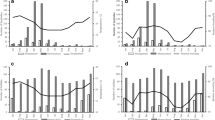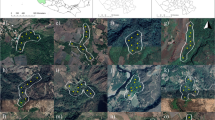Abstract
The emergence ofMusca tempestiva Fallèn, from cow pads in southern France was reduced by a mean of 98% and 96% respectively in nine experiments concluded in 1979 and 1981, by the action of the complete dung fauna. Fauna emerging from dung pads and captured in simultaneous trapping using dung baited pitfall traps consisted of 13 Dipterous species (9 Muscidae, 2 Sepsidae and 2 Sphaeroceridae), 25 Coleopterous species (7 Scarabaeidae, 1 Geotrupidae, 2 Aphodiidae, 3 Hydrophilidae, 12 Staphylinidae), 3 Hymenopterous parasites and 1 species of macrochelid and 2 species of parasitoid mites carried phoretically by the dung beetles. The total number of insects and mites per trap was usually small. The Staphylinidae which included 4Aleochara species of whichAleochara tristits Gravenhorst andA. bipustulata (L.) are known parasitoids of Diptera pupae, and 6 predatory species, were the most abundant insects present. Whilst the overall abundance of insects and mites trapped was relatively low it is probable that the most important factor in the control ofM. tempestiva was the combined influence of the different elements making up the dung pad fauna.
Résumé
Musca tempestiva Fallén (Diptera: Muscidae) est une espèce coprophage dont les larves sont très communes dans les bouses de vache du Midi de la France. Les émergences d'adultes ont été réduites respectivement de 98% et de 96% en 1979 et 1981 sous l'action de l'ensemble de la faune des bouses. Cette faune se compose de 13 espèces de Diptères (9 Muscidae, 2 Sepsidae, 2 Sphaeroceridae), de 25 espèces de Coléoptères (7 Scarabaeidae, 1 Geotrupidae, 2 Aphodiidae, 3 Hydrophilidae, 12 Staphylinidae), de 3 espèces d'Hyménoptères et de 3 espèces d'Acariens phorétiques de Coléoptères. Les espèces parasites et prédatrices, en particulier les Staphylinidae (dont quatre espèces paraistoïdes du genreAleochera), sont les plus nombreuses. Toutefois, l'abondance globale des insectes et des acariens est relativement faible: il est vraisemblable que le facteur le plus important dans le contrôle deM. tempestiva réside dans l'influence combinée des différentes composantes faunistiques de cette communauté coprophage.
Similar content being viewed by others
References
Anon. — 1983. Ecological study of the mediterranean zone. Bioclimatic map of the Mediterranean zone. 60 pp. —Recherches sur la zone aride, 31, Paris.
Bassett, P. A. — 1978. The vegetation of a Camargue pasture. —J. Ecol., 66, 803–827.
Bornemissza, G. F. — 1976. The Australian dung beetle project 1965–1975. —Australian Meat Research Committee Review, 30, 1–30.
Doube, B. M. &Moola, F. — 1988. Effect of the African dung beetleCatharsius tricornutus De Geer (Coleoptera: Scarabaeidae) upon the survival and size of the African buffalo flyHaematobia thiurouxi potans (Bezzi) (Diptera: Muscidae) in bovine dung.Bull. Entomol. Res., 76, 63–73.
Doube, B. M. — 1991. Dung beetles of Southern Africa, pp. 133–155. In: Dung Beetle Ecology (I. Hanski &Y. Cambefort, eds.).Princeton University Press, Princeton, New Jersey, 481.
Drea, J. J. — 1966. Studies ofAleochara tristis (Coleoptera: Staphylinidae) a natural enemy of the face fly. —J. Econ. Entomol., 59, 1368–1373.
Hughes, R. D., Tyndale-Biscoe, M. &Walker J. — 1978. Effects of introduced dung beetles (Coleoptera: Scarabaeidae) on the breeding and abundance of the Australian bushfly,Musca vetustissima Walker (Diptera: Muscidae). —Bull. Entomol. Res., 68, 361–372.
Hughes, R. D. — 1979. Rainfall as a cause of mortality in a dung breeding fly. —J. Aust. Ent. Soc., 18, 323–327.
Kirk, A. A. &Ridsdill-Smith, T. J. — 1986. Dung beetle distribution patterns in the Iberian peninsula.Entomophaga, 31, 183–190.
Kirk, A. A. &Wallace, M. M. H. — 1990. Seasonal variations in numbers, biomass and breeding patterns of dung beetles (Coleoptera: Scarabaeidae) in Southern France. —Entomophaga, 35, 569–581.
Legner, E. F. — 1978a. Natural enemies imported into California for the biological control of the face flyMusca autumnalis de Geer, and the horn flyHaemotobia irritans (L.). —Calif. Mosquito and Vector Contr. Assoc., 46th Ann. Cong., 77–79.
Legner, E. F. — 1978b. Introduced parasites and predators of Arthropod pests and weeds: A world review. —USDA Agriculture hand book No. 480. Washington, D. C., 346–349.
Lumaret, J. P. — 1977. Les scarabées coprophages de la Garrigue. —Ann. Soc. hort. Hist. Nat. L'Herault, 117, 98–101.
Lumaret, J. P. — 1979. Biogéographie et écologie des Scarabeides coprophages du sud de la France. I. Méthodologie et modèles de répartition. —Vie et Milieu, 28–29 (IC), 1–34.
Lumaret, J. P. &Kirk, A. A. — 1991. South Temperate Dung Beetles, pp. 97–115. In: Dung Beetle Ecology (I. Hanski &Y. Cambefort, eds.). —University of Princeton, Princeton, New Jersey, 481.
Ridsdill-Smith, T. J. — 1981. Some effects of three species of dung beetles (Coleoptera —Scarabaeidae) in south-western Australia on the survival of the bushflyMusca vetustissima Walker (Diptera: Muscidae), in dung pads. —Bull. Entomol. Res., 71, 425–433.
Ridsdill-Smith, T. J. &Matthiessen, J. N. — 1988. Bush fly,Musca vetustissima Walker (Diptera: Muscidae) control in relation to seasonal abundance of scarabaeine dung beetles (Coleoptera: Scarabaeidae) in south-western Australia.Bull. Entomol. Res., 78, 633–639.
Wallace, M. M. H., Tyndale-Biscoe, M. &Holm, E. — 1979. The influence ofMacrocheles glaber on the breeding of the Australian bushflyMusca vetustissima in cow dung. —Recent adv. Acarol., 2, 217–222.
Waterhouse, D. F. — 1974. The biological control of dung. —Scient. Am., 230, 100–109.
Wharton, R. A. — 1979. Some predators and parasites of dung breeding Diptera from Central California. —Pan Pac. Entomol., 55, 181–186.
Wright, E. J. &Muller, P. — 1989. Laboratory studies of host finding, acceptance and suitability of the dung-breeding fly,Haematobia thourixi Potans (Dipt.: Muscidae), byAleochara sp. (Col.: Staphylinidae). —Entomophaga, 34, 61–71.
Author information
Authors and Affiliations
Rights and permissions
About this article
Cite this article
Kirk, A.A. The effect of the dung pad fauna on the emergence ofMusca tempestiva [Dipt.: Muscidae] from dung pads in southern France. Entomophaga 37, 507–514 (1992). https://doi.org/10.1007/BF02372320
Received:
Accepted:
Issue Date:
DOI: https://doi.org/10.1007/BF02372320




